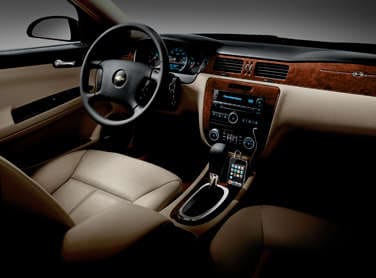Recent Articles
Popular Makes
Body Types
Chevy Impala Joins 30/300 Club

Watch out, Ford Mustang, you're about to get some new competition from an unlikely source: The 2012 Chevrolet Impala.
Okay, the two may not be rivals in any traditional sense, but remember all the fuss Ford made about how the 2011 Mustang V-6 was the first car to top both 30 mpg and 300 horsepower? Well, Chevrolet has now pulled off a similar trick with the '12 Impala. We've known the big sedan will holster GM's proven direct-injected 3.6-liter V-6 and six-speed autobox for a while, but we're now getting details on the engine's numbers and it appears the bottom line will be 302 horsepower and 30 mpg highway. Combine that with a reported starting price of $25,645, and you've got what should be a very worthwhile package for drivers who don't necessarily need gadgetry and engineering that's right on ye olde cutting edge.
Thus, while I normally don't like covering the same topic and/or brand in back-to-back columns, that's exactly what I'm going to do here by once again using the experience of GM's Bow-tie brand to illustrate the ongoing demand and/or opportunities available for retail sales of affordable basic transportation: My basic proposal being that GM could/should keep selling some of its previous-generation vehicles as "Classic" models to fill this role.
Mission: Impala-ble
The big news for Chevrolet this week is that the brand set a global sales record for the first half of the year, selling about 2.35 million vehicles around the world, which also was a 14 percent improvement over the same time last year. And while a lot of that is being driven by GM's successful efforts to boost Chevy's standing in foreign markets—sales were up in all regions in the first six months of 2011, with a notable 15 percent jump in China—U.S. sales of 904,548 units still represented more than 38 percent of the division's total volume. Then, the Impala alone accounted for nearly 11.5 percent of that amount, thanks to 103,644 sales—a 15.8 percent improvement. Taking the math to its logical conclusion, we find U.S. sales of Chevy's long-running sedan kicked in a healthy 4.4 percent of the brand's international volume for the first half of the record-setting year.
Sure, the vast majority of those are fleet sales, but the reality is that this has become the Impala's specific mission in the Chevy lineup. Chevrolet is committed to the fleet and rental market, and the Impala is its chief car for those customers, playing the same role the fleet-only Chevy Captiva Sport does for crossover applications.
Remember, there's nothing wrong with fleet sales per se. The usual complaints are that they net automakers lower profits and can dilute the brand strength of the specific nameplates involved. But with an older vehicle like the Impala, development costs and the like surely must have been paid back years ago, so the lower transaction prices are still bringing in more pure gravy.
The situation could cause some reputational problems when the next-gen Impala debuts for 2013, but things would be different in my scenario for the future, which would call for some explicit marketing differentiation between "Classic" vehicles targeted directly at fleet AND bargain-oriented customers on the one hand and current-gen products aimed at those who want all the latest/greatest goodies on the other.

Tracking the Trend
What's interesting is that the concept of offering two generations of the same vehicle at the same time for retail sale, with the older one getting a bit of a cost advantage is already taking shape elsewhere thanks to the vagaries of vehicle design and new-product cadences.
For example, Chevy is working that angle itself with the Chevrolet HHR—built on the same platform as the now-defunct Cobalt—at the same time it sells the Cobalt's replacement, the Chevrolet Cruze. This little experiment is almost over, with HHR sales dropping to just 870 units in June, but the car did contribute 35,502 units to Chevy's bottom line in the first half of the year.
And Hyundai and Nissan are doing something very similar in the compact and subcompact segments, respectively. For the South Korean automaker, while the all-new 2012 Hyundai Elantra is getting most of the buzz, the automaker hasn't gotten around to reworking the Hyundai Elantra Touring yet, so it soldiers on with the same basic package it offered in the 2011 model year—and the same price, too. As a result, while most hatchbacks cost more than there sedan counterparts, the opposite is the case with the Elantra siblings.
The same thing is going on with the Nissan Versa. The 2012 sedan is all-new, and while it's still the least-expensive car in the U.S., it did see a full $1,000 bump in price. The Versa hatchback is unchanged for the new model year, but so is its MSRP.
And while the pricing situation at Volkswagen goes the other way, it is worth pointing out that the VW Jetta sedan is, of course, all new, while the VW Jetta SportWagen retains its 2011 setup. The difference at the German company is that the SportWagen still continues with the Jetta's near-premium-ish package and pricing and it's the sedan that showcases the (significantly) lower MSRP.

Emerging Opportunities
The Chinese auto industry provides yet another twist on the approach, courtesy of the machinations of BAIC, which purchased previous-generation Saab platforms from GM with the intention of leveraging them to create "new" vehicles in the world's largest auto market.
You can call it the ultimate form of recycling, but I call it an ideal way to deliver low-cost, high-quality vehicles to the growing number of people who—for all different kinds of reasons in all different kinds of markets— prefer exactly that.
